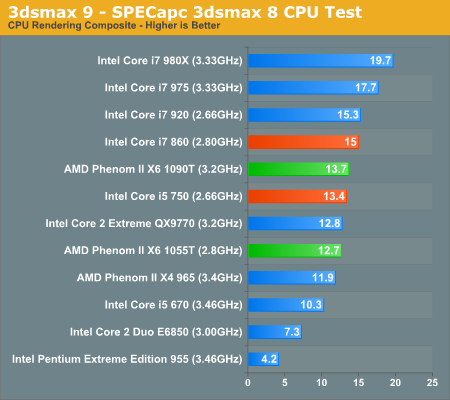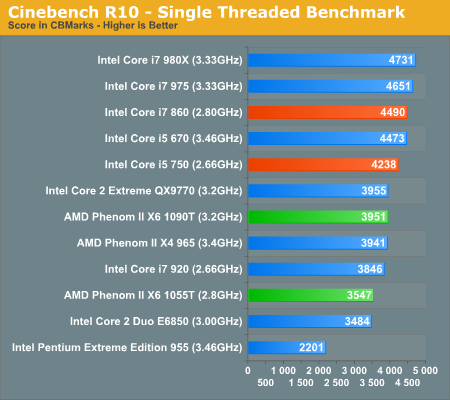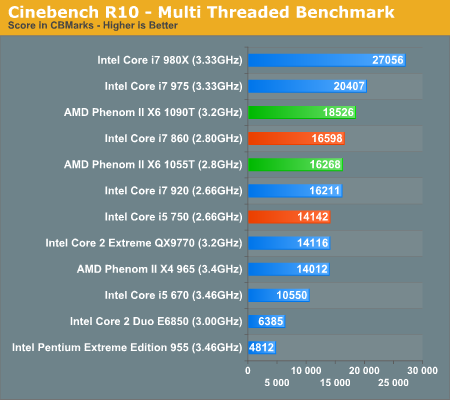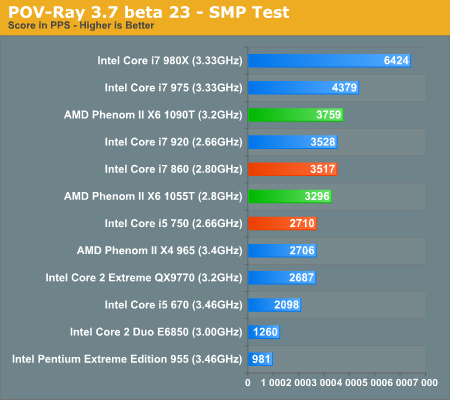AMD's Six-Core Phenom II X6 1090T & 1055T Reviewed
by Anand Lal Shimpi on April 27, 2010 12:26 AM EST- Posted in
- CPUs
- AMD
- Phenom II X6
3dsmax 9 - SPECapc 3dsmax CPU Rendering Test
Today's desktop processors are more than fast enough to do professional level 3D rendering at home. To look at performance under 3dsmax we ran the SPECapc 3dsmax 8 benchmark (only the CPU rendering tests) under 3dsmax 9 SP1. The results reported are the rendering composite scores.
Not all heavily threaded workloads will show the Phenom II X6 in a good light. Here Intel maintains the advantage:

Cinebench R10
Created by the Cinema 4D folks we have Cinebench, a popular 3D rendering benchmark that gives us both single and multi-threaded 3D rendering results.
Single threaded performance is obviously an Intel advantage, but crank up the thread count and there's no match for the Phenom II X6. As we pointed out earlier, if you've got a lot of CPU intensive threads there's no replacement for more cores.


POV-Ray 3.73 beta 23 Ray Tracing Performance
POV-Ray is a popular, open-source raytracing application that also doubles as a great tool to measure CPU floating point performance.
I ran the SMP benchmark in beta 23 of POV-Ray 3.73. The numbers reported are the final score in pixels per second.
Once again, the Phenom II X6 does very well here.











168 Comments
View All Comments
chrnochime - Tuesday, April 27, 2010 - link
Even with the 930 being 200 at MC(I got one nearby so yes I know that), X58 motherboards are still more expensive overall. The cheapest is 160+, and goes to 400. The thing is with x58, just finding a decent board that doesn't have a bunch of weird problems voiced by owners on forums/newegg is very very difficult. One has to either spend around 300 to perhaps have a higher chance of buying a relatively problem-free board, or just pray the board that arrives doesn't have one of the memory slot DOA(seems to plague quite a few mobos).I don't think the situation is anywhere nearly as bad on AM3 side.
Too bad it's not like the old days (5+ years ago) when boards would just WORK without having to eff around to even keep it stable at stock speed.
vectorm12 - Tuesday, April 27, 2010 - link
I'd really like to see how the 1055T stacks up in terms of overclocking ability.Seems to me as if the 1055T overclocked to around 3.4-3.6 GHz would result in a good stepstone from the current Phenom X4 (non black edition) lineup.
Etern205 - Tuesday, April 27, 2010 - link
Just to give a heads up that Maxxon released a new Cinebenchversion R11.
Roland00 - Tuesday, April 27, 2010 - link
If you are building a new system, of course you will want to use DDR3 memory for there is little to no price difference between the two.But some people have older systems. I wouldn't be surprised if people are upgrade from their AMD 5000+ or 6000+ and they have a compatible motherboard and memory. I am just wondering how much of a bottleneck is the DDR2 and will it cause any rational not to do a partial upgrade but instead a full upgrade.
It doesn't have to be all the tests, just a couple.
Taft12 - Wednesday, April 28, 2010 - link
IIRC the tangible performance benefit from DDR3 over DDR2 is in the range of 2%Higher speed but higher latency.
Goopfruit - Tuesday, April 27, 2010 - link
w00t! Go Netburst!xD
LoneWolf15 - Tuesday, April 27, 2010 - link
That my Q9450 clocked to QX9770-spec is still very competitive.I think it will be awhile before I change platforms, especially what with Intel planning socket changes for 2011. By then, we should see some more interesting options and maybe DDR3 will drop in price --I can always dream.
bigboxes - Tuesday, April 27, 2010 - link
When testing your 1366 i7 CPUs you need to use 6gb of ram. Why? Because they can utilize that extra bandwidth for increased performance. You stated that early on, but since 1156 came out your tests have been only with 4gb of ram. Drop 6gb of ram in the 1366 and retest. I'm sure that is what most 1366 owners are using in their systems.Anand Lal Shimpi - Tuesday, April 27, 2010 - link
In order to keep memory size constant we use 4GB on all systems (4x1GB on the LGA-1366 boards). You get full triple channel access for the first 3GB of memory, only the final 1GB is limited to dual channel. It's the only compromise we could come up with short of giving LGA-1366 a memory size advantage.The vast majority of our tests fall in the 2 - 3GB range, so I don't believe we're holding back the Nehalem/Gulftown performance much if at all here.
Take care,
Anand
Makaveli - Tuesday, April 27, 2010 - link
if most of the benchmarks use only 2-3GB's what differenece then does it make to have the i7 with 6gb of ram?